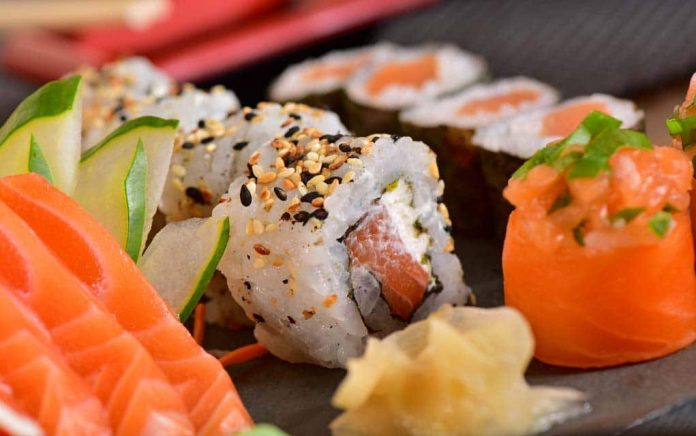
I love Asian food. Thai, Szechuan, Vietnamese, Japanese-you name it-I love it.
If you’re like me, then what I’m about to tell you will be very upsetting.
On a recent family sushi outing, I ordered a seaweed salad. I’m a fan of seaweed because of its health benefits including iodine, vitamins and minerals. All three of my kids enjoy snacking on seaweed too, and often eat it straight from the package. However, when I took a look at the bright green seaweed salad placed in front of me at the restaurant, my “Scary Seven” radar immediately went off. It looked too “bright” and too “green” to be healthy, so I suspected it had food coloring in it. I asked the waiter to see the ingredients. He told me they were in Japanese and even he didn’t understand them. So I asked a Japanese friend to translate them for me.
Here they are:
(Note: The red highlighted ingredients are on our Scary Seven list, the orange one is on our Also Beware of list and the blue signifies a potential GMO ingredient.)
Ingredients: Wakame, agar, high-fructose corn syrup, vegetable fat and oil, sugar, sesame seeds, salt, vinegar, glucose syrup or starch syrup (“Mizuame”), hydrolyzed protein, cloud ear mushroom, red pepper, glucose, seasoning (amino acid, etc.), acidulant, food coloring (Yellow #4 and Blue #1). Whoa! I was right.
While I had suspected it contained food coloring, I didn’t expect it to also contain high-fructose corn syrup, MSG, potential trans fats, and GMOs. This seaweed salad just went from "health food" to "health threat."
This was the third restaurant I had eaten at and asked to see the ingredients. However, this was the first restaurant that was willing to provide them to me. The other two denied my requests.
What a disappointment. I was told that many restaurants, who don't make their own seaweed salads, order it in bulk from distribution companies who then deliver it pre-made to restaurants. I have come to learn how to tell if a seaweed salad is pre-made simply by looking at its color — it is generally bright green, as pictured at the top of this article.
That led me to wonder what harmful ingredients might be lurking in other popular sushi ingredients. Here's what I found:
Ginger
Best known for promoting circulation, curbing nausea, and improving digestion, ginger has been used in Chinese Medicine for centuries. Studies show that its active ingredient, gingerol, plays an important role for ovarian and colorectal cancer prevention, as well as decreasing inflammation in the body. When it comes to sushi, pickled ginger is used to cleanse the palate between dishes.
The traditional pickling process turns ginger pale yellow or slightly pink. However, many Japanese restaurants serve bright pink ginger which contains food coloring, specifically Red #40, or Allura Red.
Here is a jar of ginger I found on the shelf at an Asian grocery store. As you can see, it contained the following Scary Seven ingredients:
- Potassium Sorbate, a preservative that can lead to DNA damage.
- Monosodium Glutamate or MSG, which is linked to chest pains, heart palpitations, excessive sweating, and headaches.
- Aspartame, an artificial sweetener which primarily affects thenervous system, and is linked to headaches, anxiety, memory loss and ahost of other side effects.
- And artificial colors (FD&C Red #40 or Allura Red), whichare linked to allergies, nasal congestion and hyperactivity in children.

The second jar of ginger, pictured below, contained these harmful ingredients:
- Potassium sorbate, which is linked to allergic reactions and nausea.
- Aspartame, likely GMO.
- Red #40, which is made mostly from petroleum and is a potential carcinogen.
[Note: I didn't circle the harmful ingredients in red because of the angle of the label, but as you can see, they are there!] 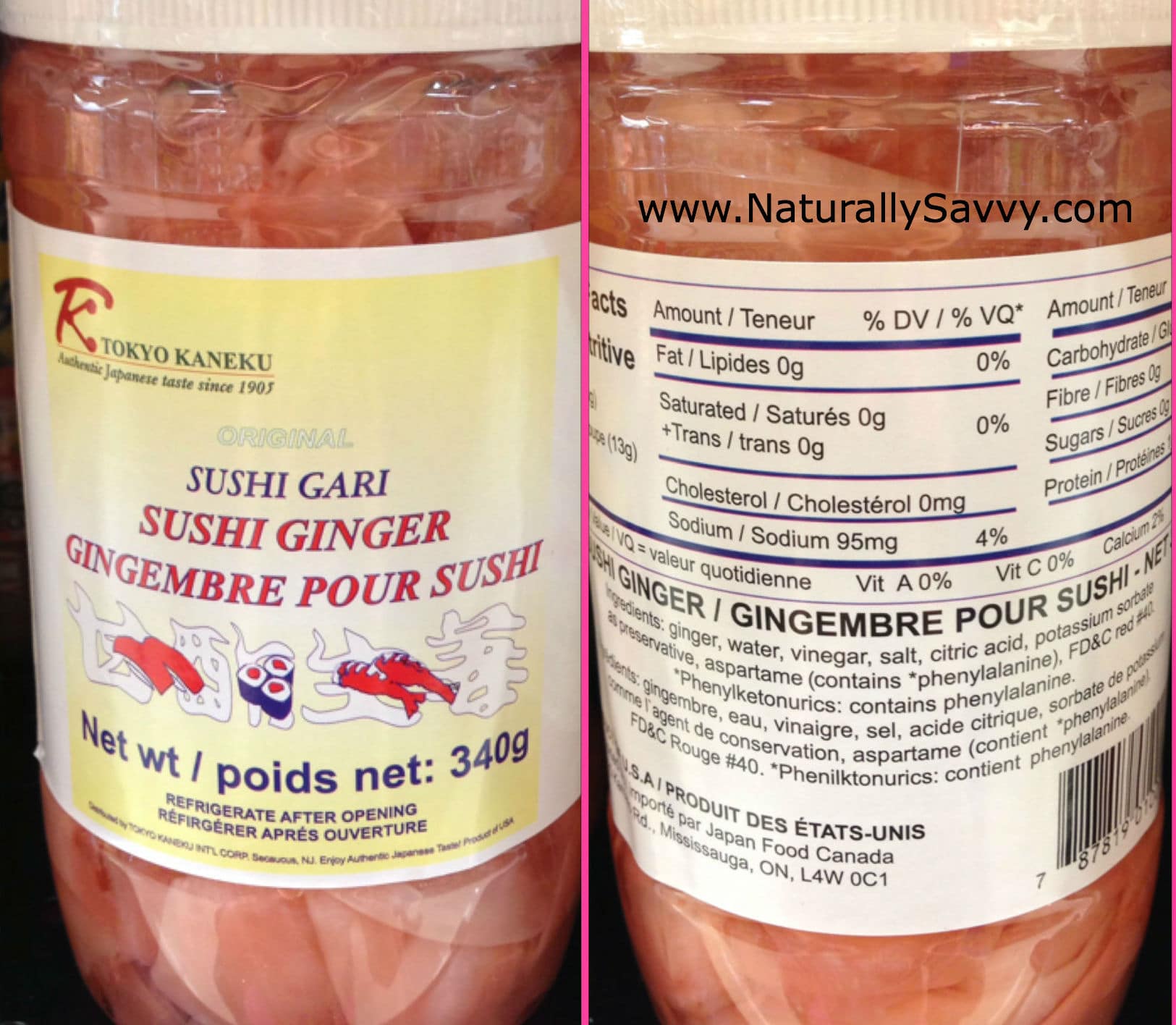
And the third jar (pictured below) contained: Sodium benzoate, which is linked to allergic reactions, and Red #40 (Allura red). 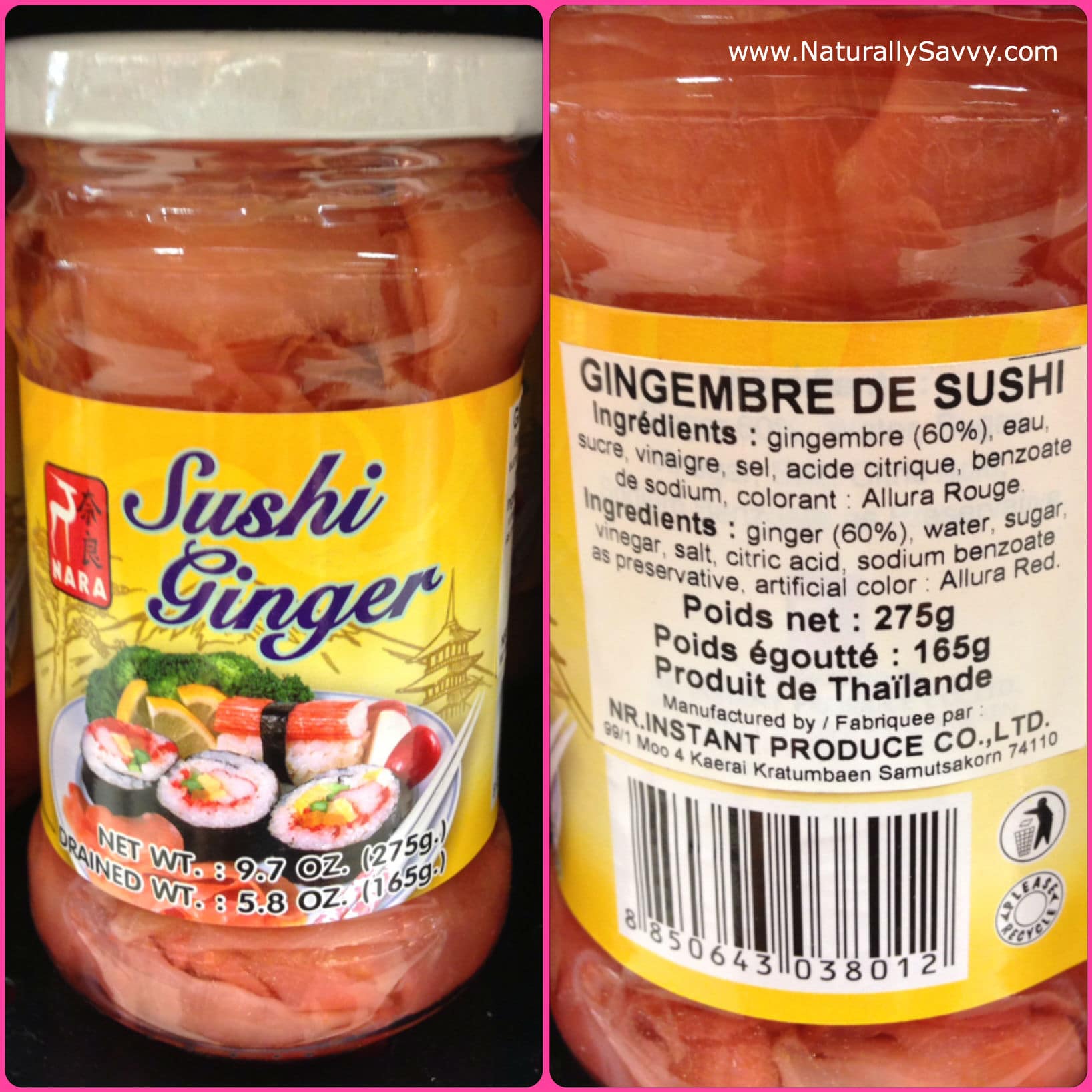
I always thought the white (or yellow ginger) was a better option. Until now. 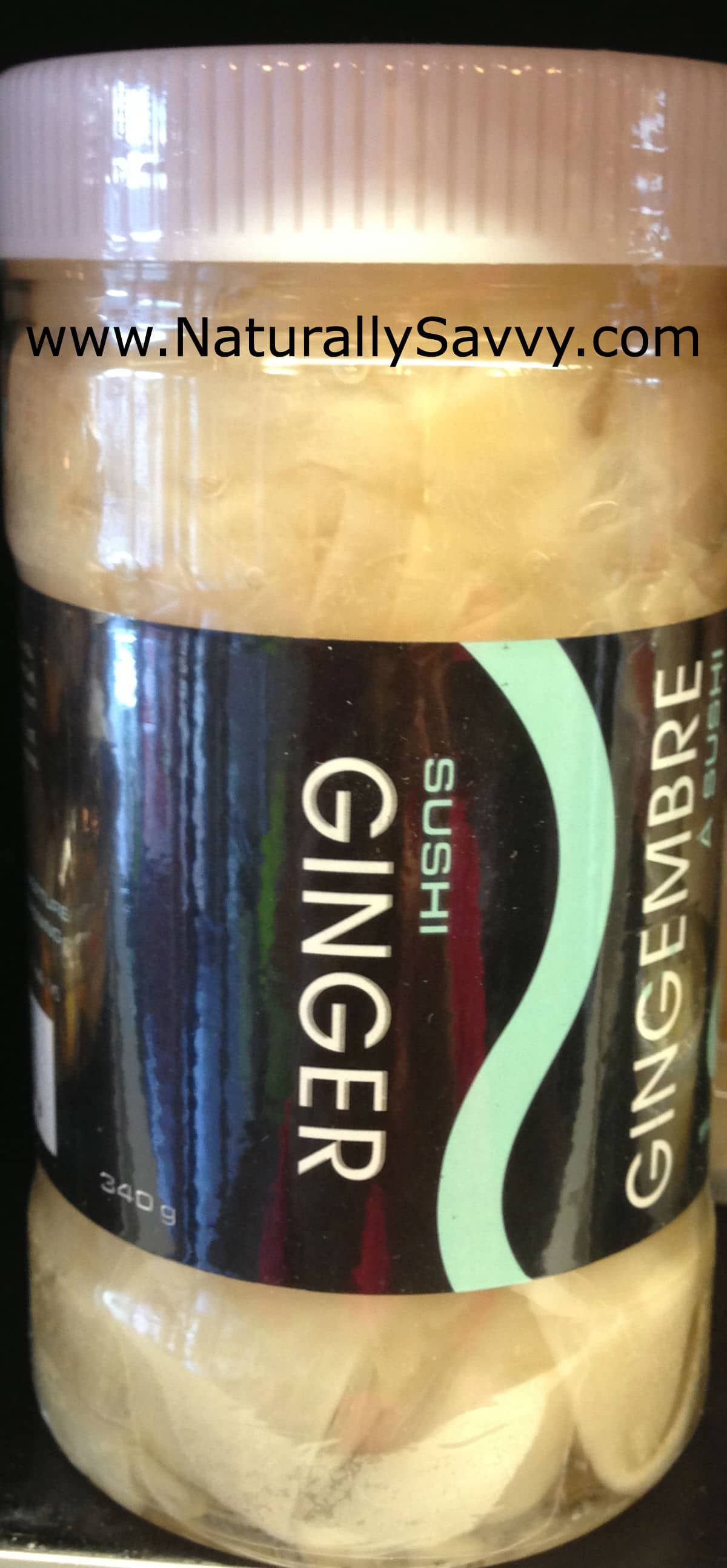
On a recent outing to a second local sushi restaurant, I discovered that some brands of white (or yellow) ginger contain aspartame. This brand in particular also contained potassium sorbate and potential GMOs like citric acid. 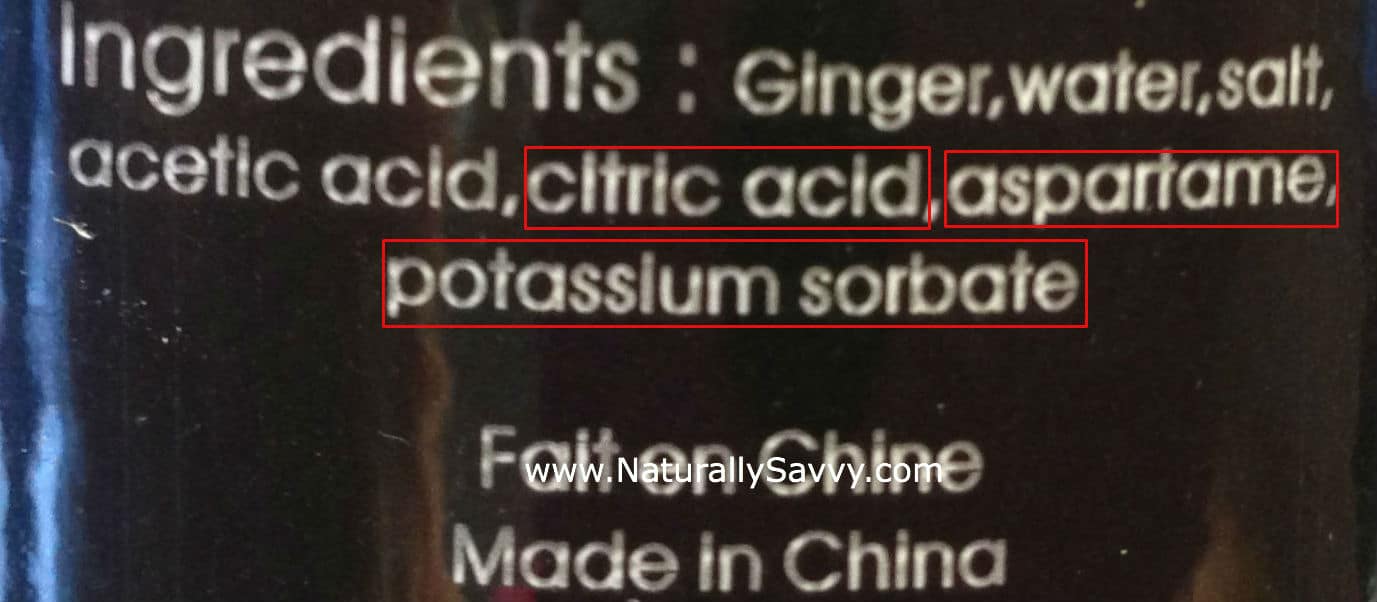
Unfortunately, this well-known root, or rhizome, is not so healthy when harmful chemical-additives are used to make it look good, taste better, and last longer.
The good news is that I did find a clean version of [organic] ginger which didn't contain any harmful ingredients at my local health food store (pictured below). Its ingredients were: organic ginger, organic cane sugar, water, and naturally fermented rice. I'll be sure to bring some with me next time I go out for sushi (because the chances of any sushi restaurant serving something as clean as this are slim to none). 
Wasabi (or at least that's what they call it at sushi restaurants)
Authentic wasabi, an herb, also known as the herb Wasabia japonica, contains anti-inflammatory and antibiotic properties. However, the majority of the wasabi you find in sushi restaurants (even in Japan!) is an imitation made from Japanese dry mustard, horseradish and food coloring. Although rare, you can find authentic wasabi at high-end, elite restaurants. Its color is green. Very different from what you find served at restaurants or sold in stores.
Pictured below is the real root-like rhizome. It has only ingredient: wasabi. 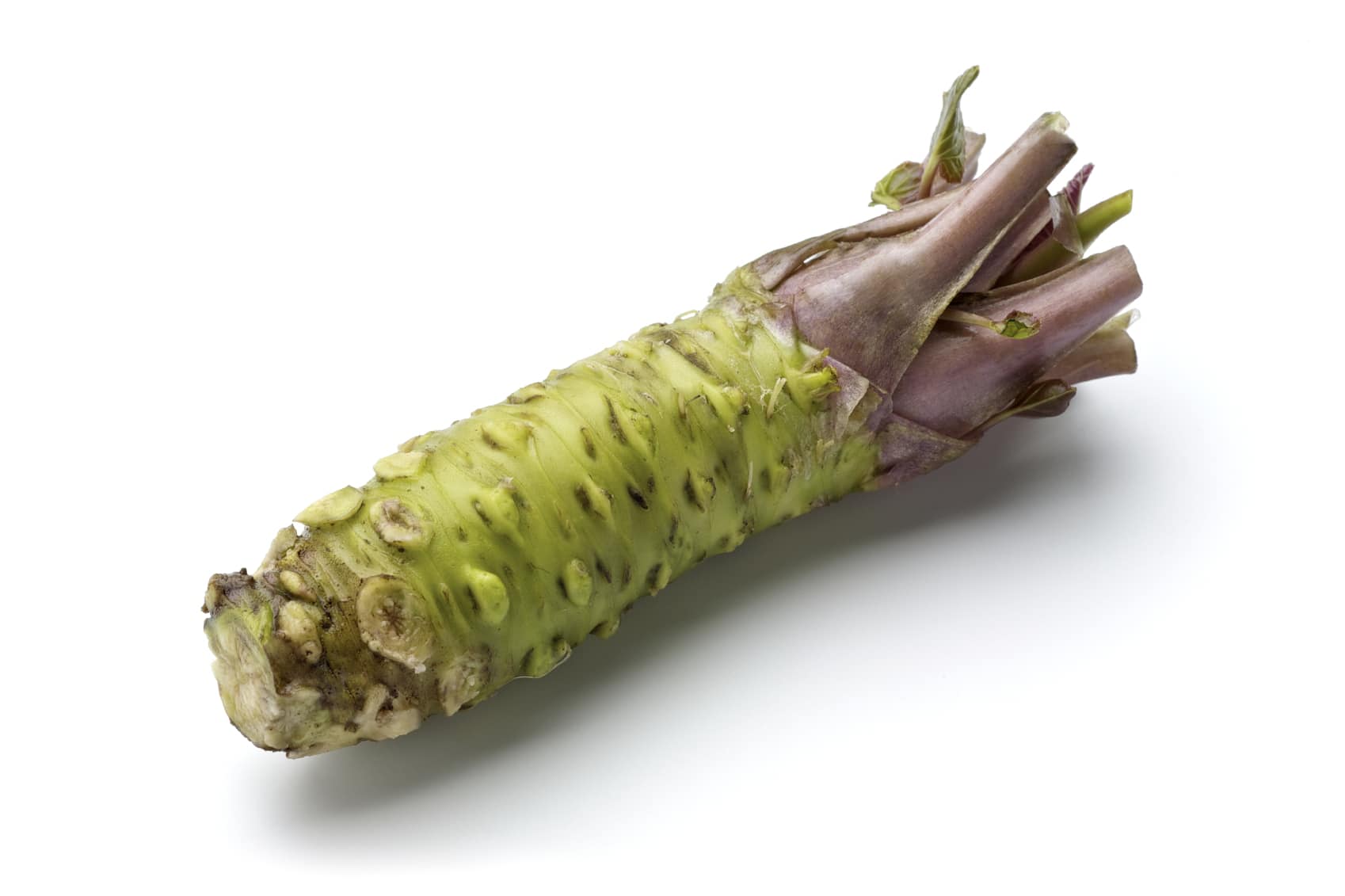
And pictured below are the ingredients for the typical wasabi served to you at sushi restaurants. 
As you can see from the red highlights on the products above and below, the North American version of wasabi contain chemical-additives:
- Artificial flavors
- Artificial colors such as Tartrazine (Yellow #5 and Blue #1)
- [Potential] GMOs, including rapeseed oil (canola oil), soy, citric acid, cornstarch, and corn flour
Here is another brand: 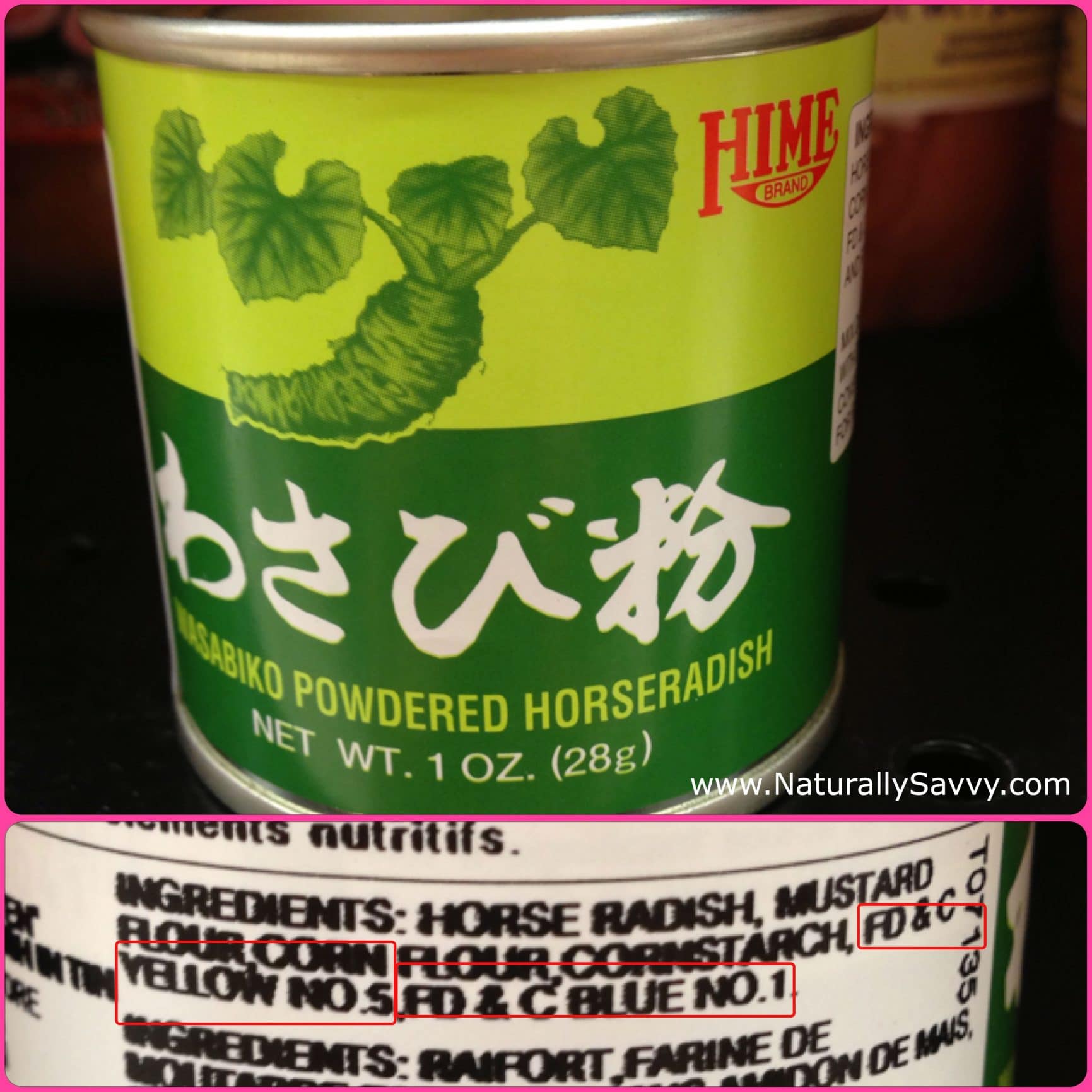
I was able to find a cleaner brand of wasabi (pictured below) that only listed three ingredients: horseradish, spirulina and turmeric. If you are unable to obtain the fresh root to make your own, this would be a better option if you are planning on making homemade sushi. 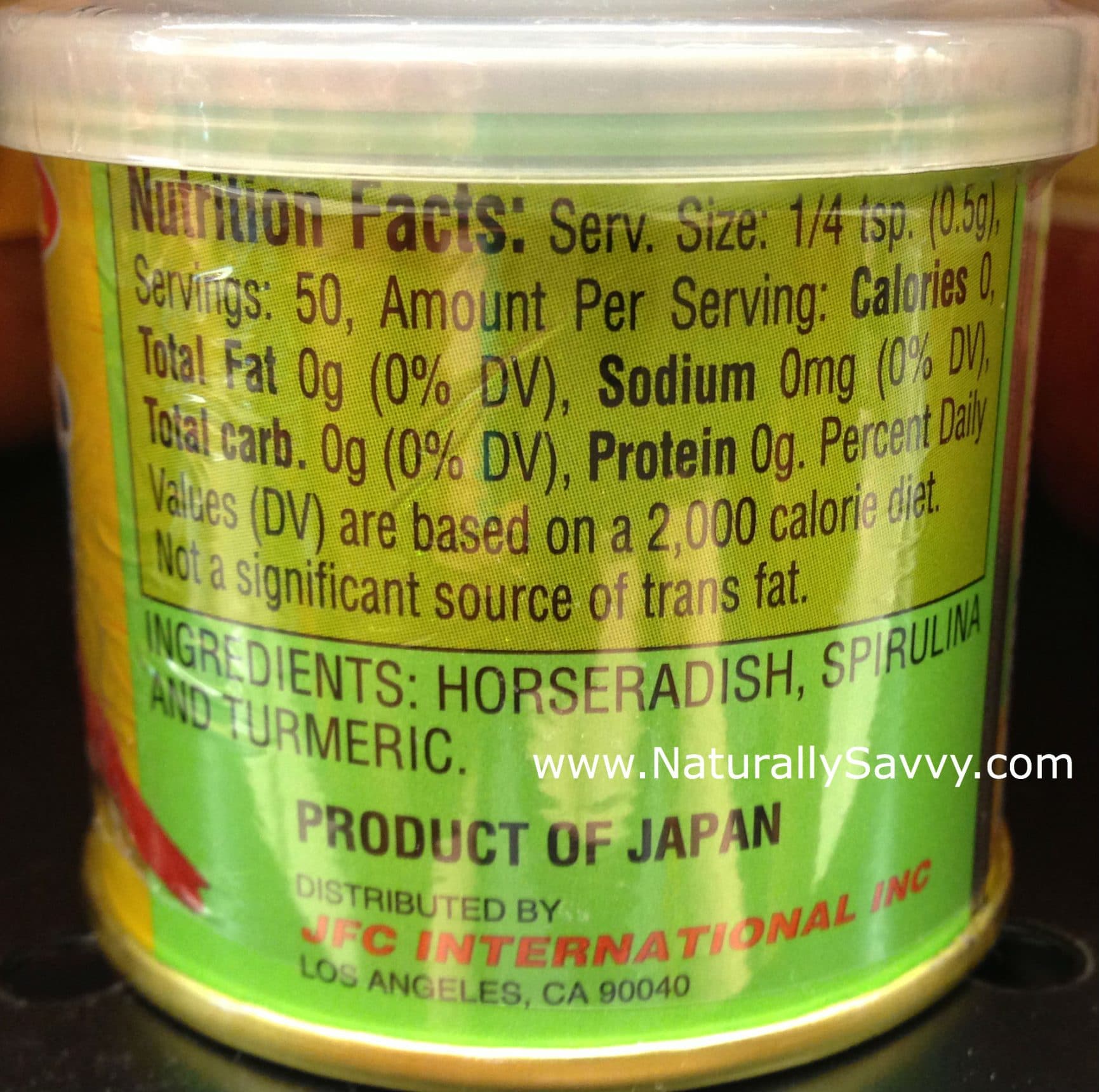
Sesame Seeds
Rich in calcium, magnesium, manganese and copper, sesame seeds' health benefits are vast. Sesame seed oil has been shown to have anti-cancer effects, lower blood pressure, and help with depression. All this being said, those benefits are erased when other harmful ingredients are added to the formula, like artificial sweeteners and artificial colors. Sesame seeds are typically used on the outside of a sushi roll for appearance and flavor.
Pictured below is a jar of flavored sesame seeds. Although it has a short ingredient list and you can understand everything on the label, it contains the artificial sweetener, sucralose, and “coloring”, which means-artificial colors. Since this product's label clearly states it is a "Product of Taiwan", and they have mandatory GMO labeling there, we would assume the sugar used in this product is non-GMO. However, because their labels have been adapted to North American labeling, companies can remove their non-GMO claims to conform to North American labeling laws.
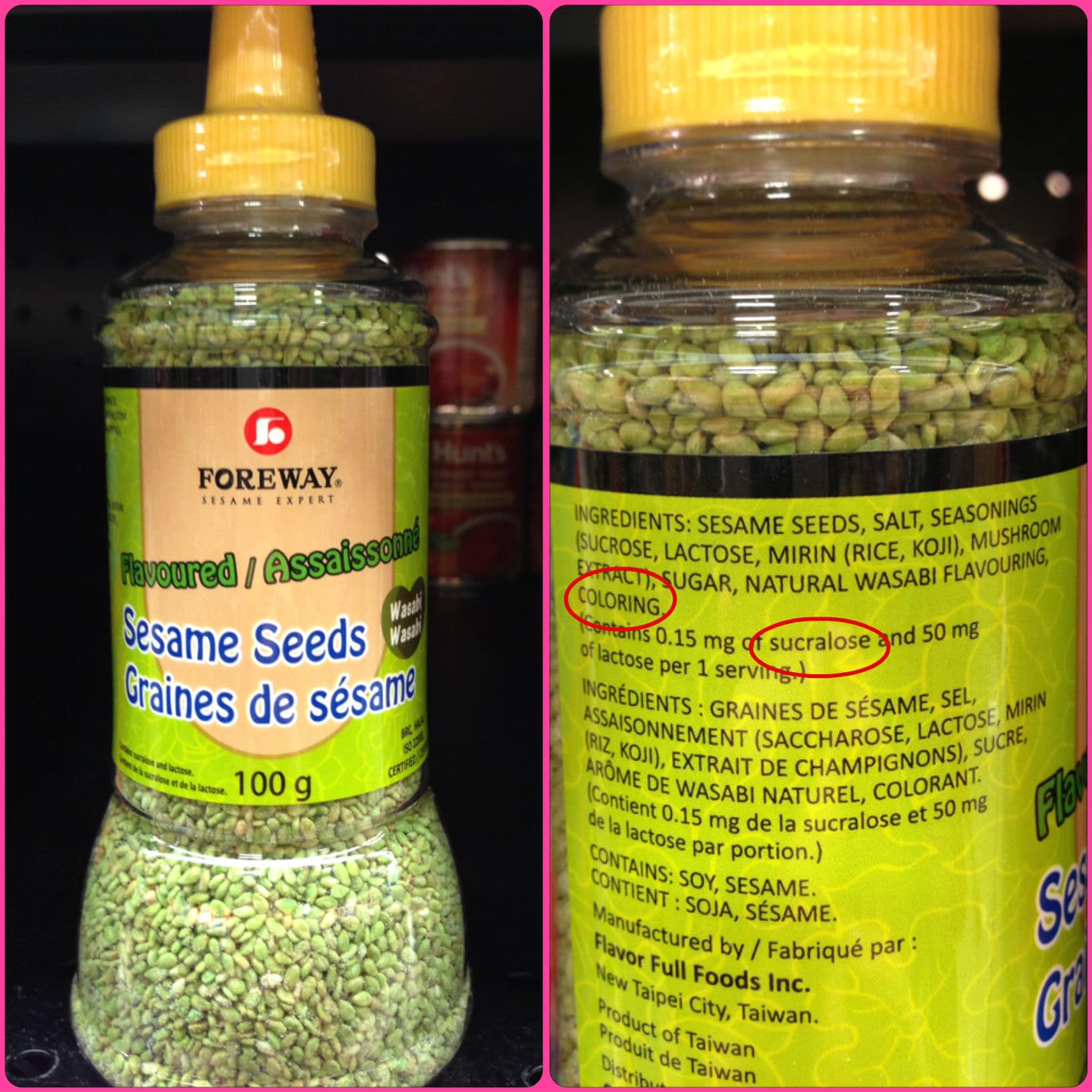
Sushi restaurants generally use non-flavored, toasted sesame seeds in their dishes, however, I wanted to point out that even something as simple as a sesame seed can contain harmful additives. So it is important, like with everything else, to always read the label and not assume it is a clean product.
Soy Sauce
When it comes to sushi, soy sauce is traditionally used for rolls. This tasty condiment is also used in a plethora of dishes including stirs fries and soups. In our first e-book: "Label Lessons: Your Guide to a Healthy Shopping Cart", we compared La Choy Soy Sauce to San-J's Tamari Sauce and showed how conventional soy sauce can contain GMOs, hydrolyzed soy protein (MSG) and the preservative potassium sorbate.
La Choy's ingredients are as follows: Water, salt, hydrolyzed soy protein, corn syrup, caramel color, potassium sorbate [preservative].(Note: The red highlighted ingredients are on our Scary Seven list, the orange one is on our Also Beware of list and the blue signifies a potential GMO ingredient.)
The soy and corn used in the La Choy Soy Sauce is GMO because the company (ConAgra) told me so. The person I spoke to told me that most of their products use biotechnology and its most prevalent use is with their products containing corn and soy. When I asked if the soy and corn used in this specific product was non-GMO, she told me she could not confirm that it was.

Hydrolyzed soy protein is a flavor enhancer derived from genetically modified soy and is rich in glutamic acid, which may cause reactions similar to MSG, such as headaches, chest pains, sweating, and heart palpitations.
Caramel color is classified as a 'natural colorant,' but there are many types of caramel color, and labels don't have to disclose which ones they use. Caramel color IV is the most dangerous type, which is made by reacting sugars with ammonium and sulfite compounds resulting in the formation of possible carcinogenic by-products.
Sorbates, like potassium sorbate, are used to prevent the growth of molds, yeasts, and other bacteria. They have been linked to irritable bowel symptoms, asthma, eczema, and behavior issues in children.
In our house we are big fans of San-J's tamari soy sauce and use it to flavor many of our dishes. I even bring their travel packets with me when I eat out (as you can see from the picture below, taken at the same restaurant I ordered my seaweed salad from). I'm gluten free, so I avoid most brands of soy sauce as they contain wheat. The best part is that San-J's tamari sauce is Non-GMO Verified so you know they do not use biotechnology in their tamari products. 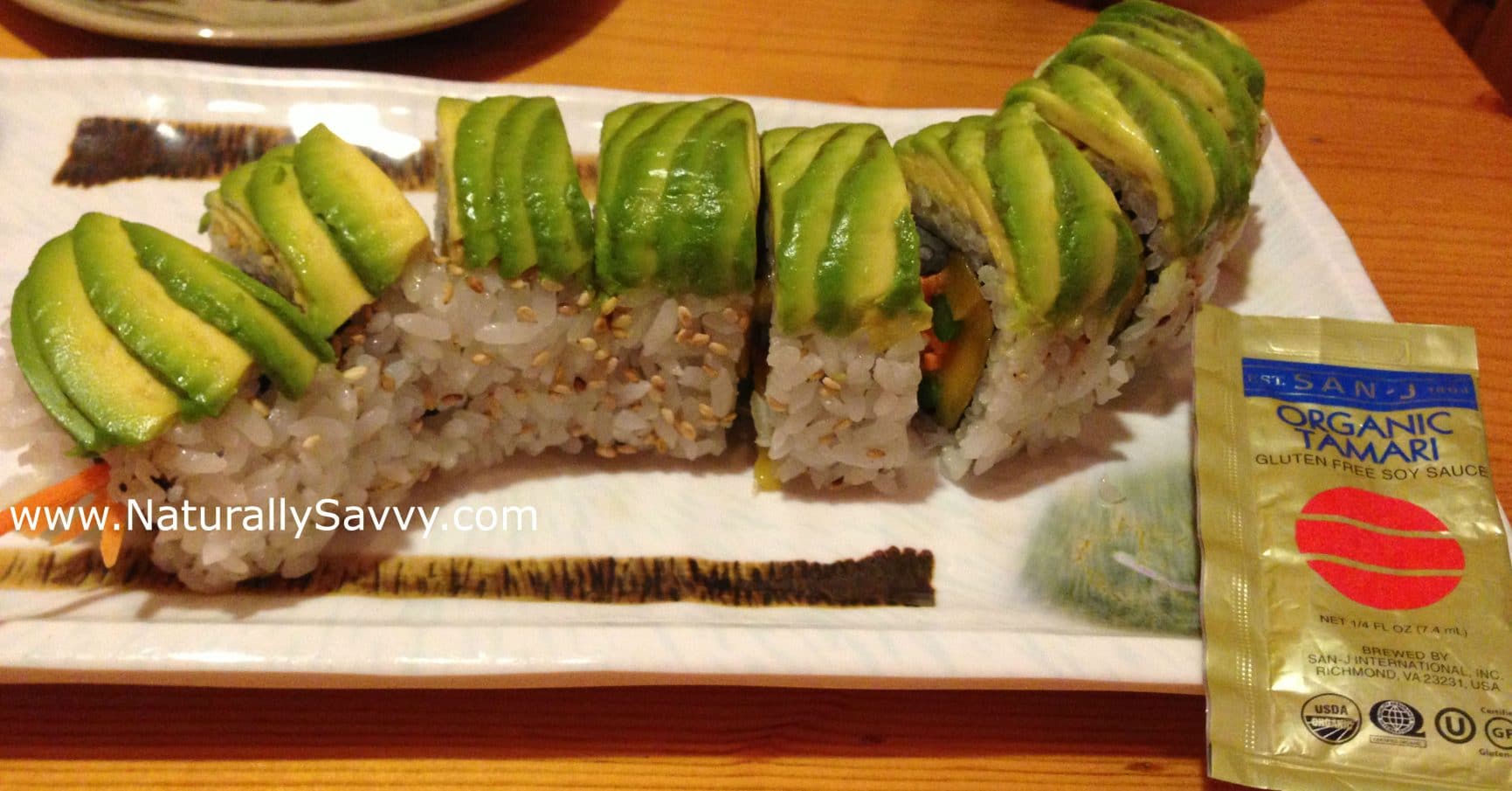
Rice Vinegar
I’m happy to report that all the rice vinegars I researched did not contain harmful chemical additives. Their only ingredients were rice and water. I did find organic rice vinegars on the shelf at my local Asian grocery store, which I was happy to see.
Rice
You will find rice on every sushi menu as it is used for sushi, hand rolls, and maki rolls. Although it is not served with every dish, like sashimi for example, you can guarantee it will be on a Japanese restaurant's menu.
I travel a lot for work, and I'm always looking for healthy gluten-free grab-and-go options that tide me over until I'm able to eat something more substantial. On a recent visit to Wisconsin for a talk I was giving on 'Unjunking Your Junk Food' I found a market that sold many organic, fresh foods. I was excited. But, when I went to the sushi counter and asked to see a list of the ingredients of their veggie rolls, I was disappointed to see it contained high-fructose corn syrup. I have seen a lot of prepackaged sushi that contained aspartame or high-fructose corn syrup to sweeten the rice. I even found high-fructose corn syrup listed on take-out sushi at Whole Foods once and brought it to their attention (Whole Foods outsources the sushi counter to a third company). They were super reactive and immediately pulled it from the shelf.
So, although sushi might seem like the healthier option when you are in a hurry, read the ingredients to make sure they don't contain any of the Scary Seven ingredients.
Here's a package of sushi I recently spotted in a pharmacy in California in their prepared foods cooler at the front of the store: 
The ingredient list is so long I had to photograph it from several angles to be able to capture all of it, and even that was hard. This package of sushi contained an array of chemical additives including: MSG, artificial sweeteners, artificial colors, preservatives, and GMOs.
Not such a healthy option after all. 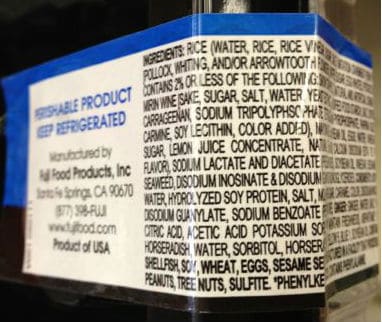
Mock-Crab (or Imitation Crab Sticks)
A favorite among young and old, mock-crab is infamous in California rolls, but what exactly is it made of? Not real crab!
Instead, mock-crab is made from a combination of [Golden] Threadfin Bream, crab flavoring [artificial flavor(s)], egg whites and MSG. Threadfin Bream is a species of fish found in the Indian and Pacific Oceans. According to WWF Hong Kong’s 2013 Seafood Guide Book, Golden Threadfin Bream is facing extinction, and they are warning people to avoid eating it all together. This is reason alone to ‘pass’ on the California Roll next time you order in sushi.
Below are pictures I took of different brands of mock-crab: 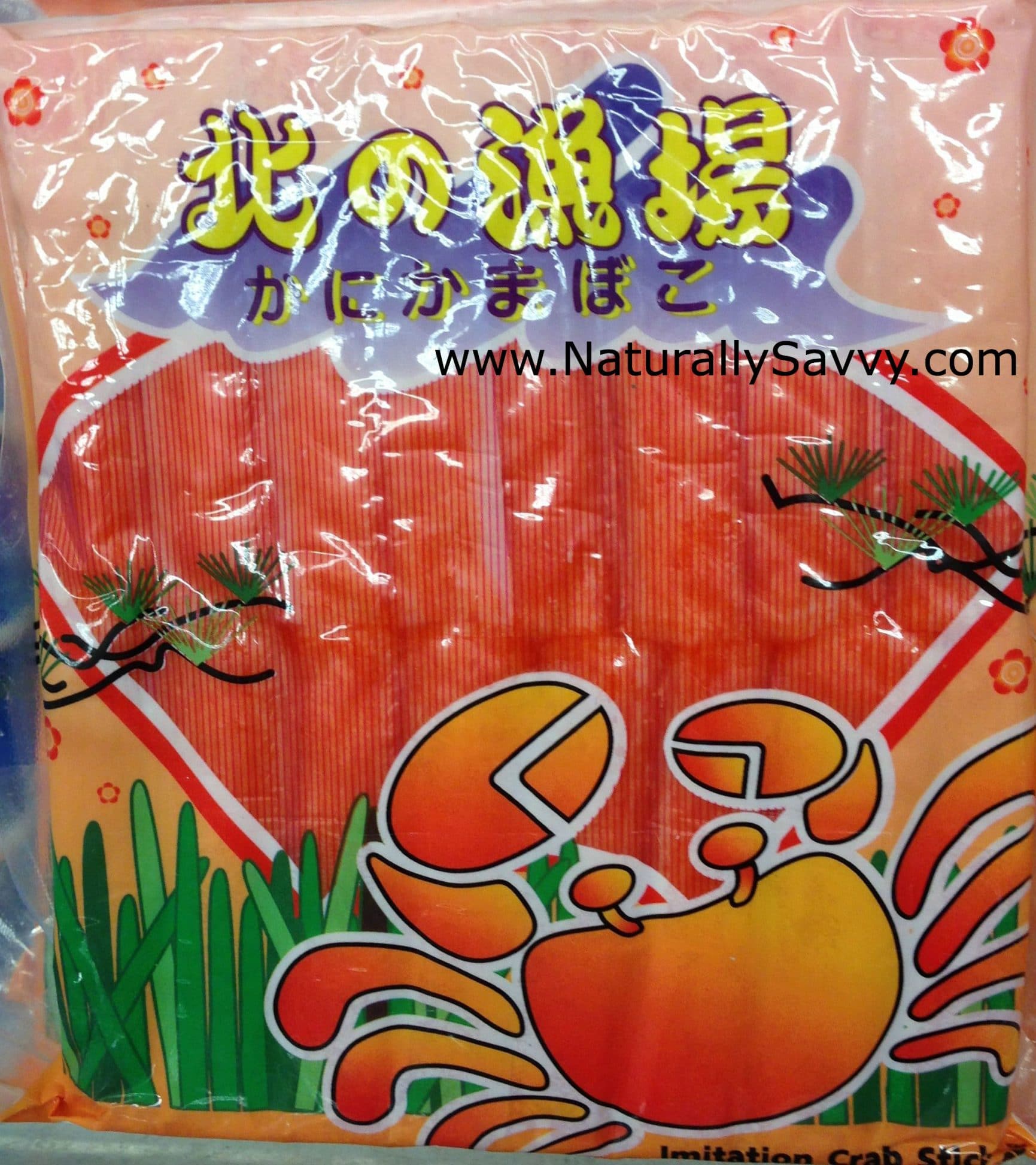
Here are the ingredient lists from three different brands:

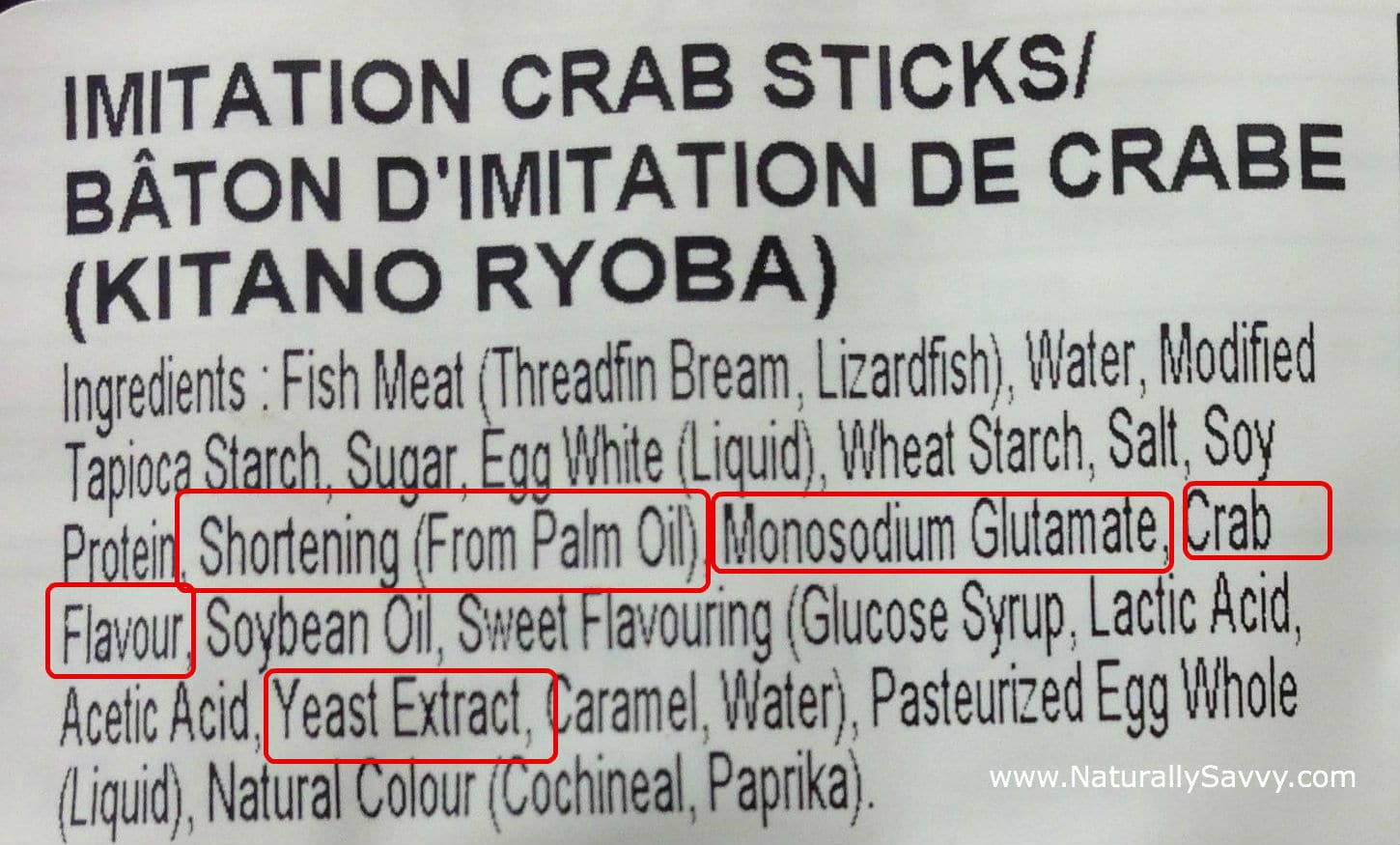
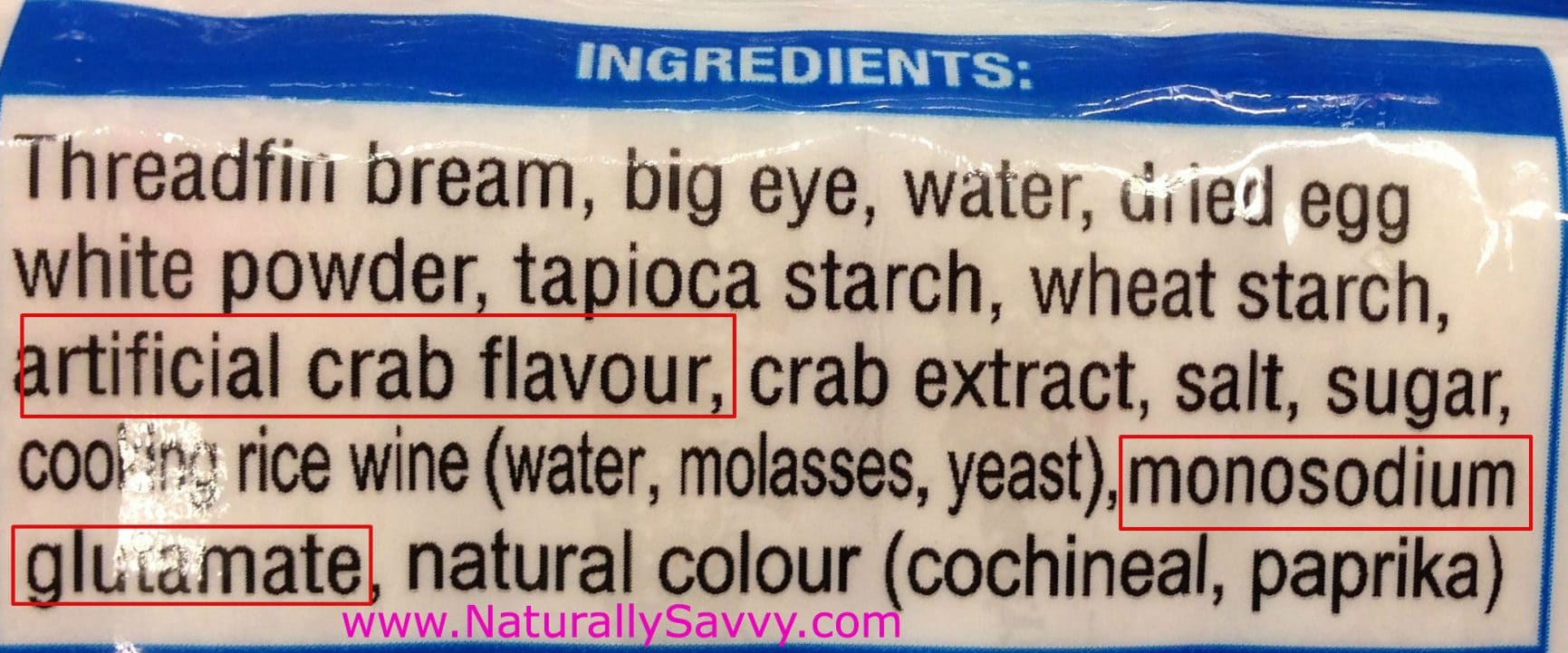
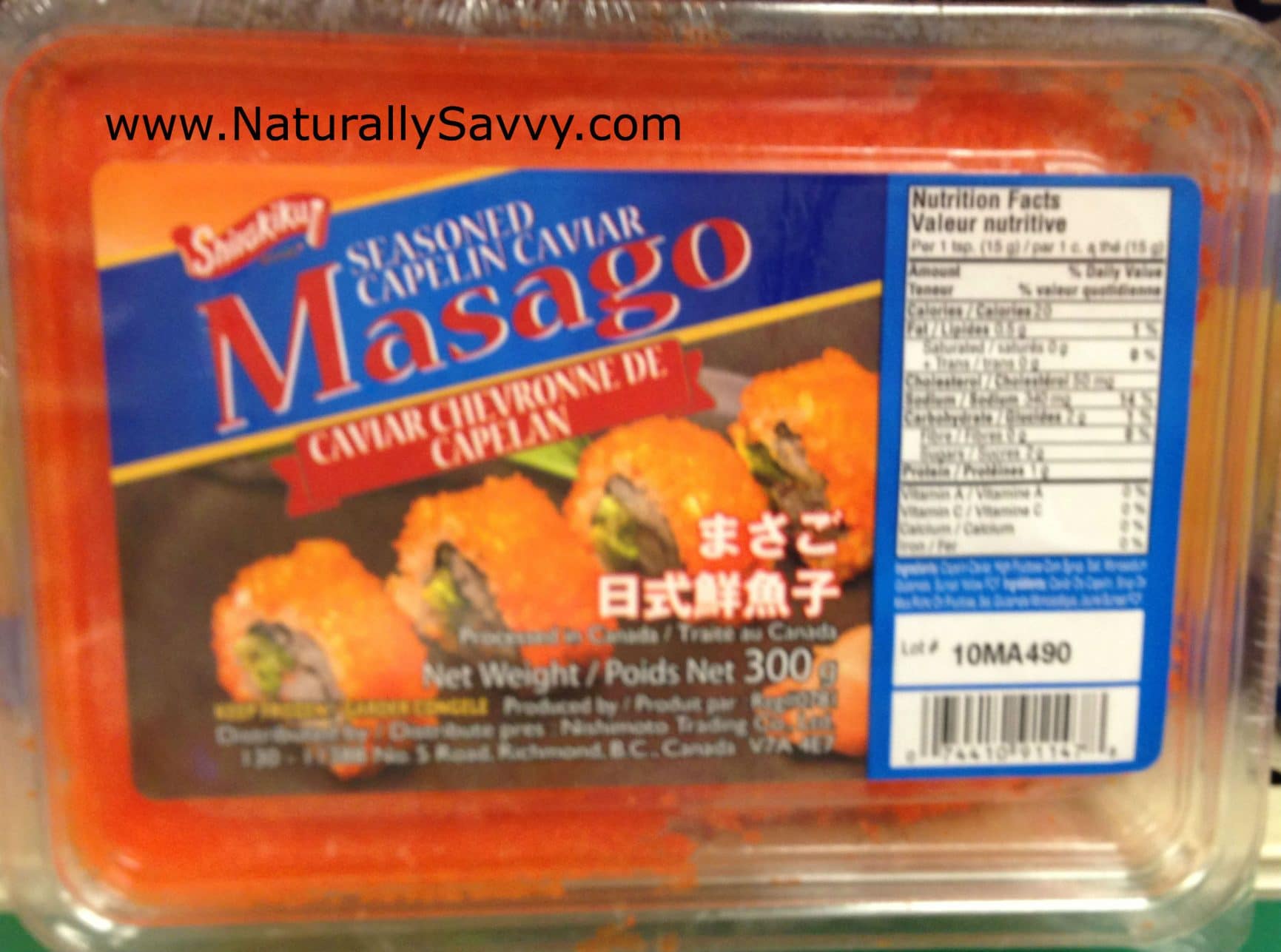
Fish Roe (Flying Fish Eggs, Seasoned Caviar)
As you can see, these pictures are a little blurry. That's because I took them quickly. The security guard from the store stopped me from taking pictures but he was nice enough to let me take "two more". Busted.
I did manage to get a snapshot of their ingredients, and at this point-sadly, I wasn't surprised at what I found.
As you can see, they both contained monosodium glutamate (MSG), and yellow #6 (Sunset Yellow). One brand also contained high-fructose corn syrup. 
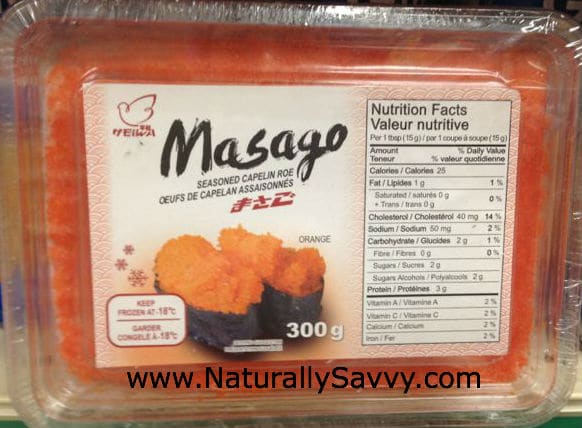

If you ever get headaches after eating sushi, the MSG found in many of its components could be the culprit. I would recommend passing on the roe next time you order sushi rolls.
Would you like some BPA with your sushi?
I’d love to say that my expose stops at the ingredients, but unfortunately it doesn't. When I was leaving the restaurant, I happened to notice dishes sitting at the counter ready to be picked up by the waiters. In order to maintain organization, the sushi chefs put the order receipt on top of the sushi rolls that were ready to be served.
Now, you might be wondering why this matters.
Thermal paper cash receipts, along with aluminum cans, water bottles, baby bottles, and baby formula cans contain Bisphenol-A (BPA). BPA is an industrial chemical used to make certain types of plastics and resins. It has been linked to obesity, cancer, decreased sperm count, kidney damage, and developmental damage to unborn children. It can easily rub off onto your hands so placing it on top of food would lead me to believe it can rub off on that as well.




